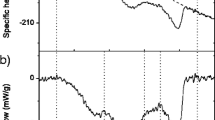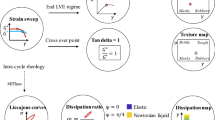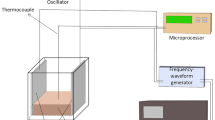Abstract
We present an accurate two-dimensional mathematical model for steak cooking based on Flory–Rehner theory. The model treats meat as a poroelastic medium saturated with fluid. Heat from cooking induces protein matrix deformation and moisture loss, leading to shrinkage. Numerical simulations indicate good agreement with experimental data. Moreover, this work presents a new and computationally non-expensive method to account for shrinkage.








Similar content being viewed by others
References
M.M. Farid, Mathematical Modeling of Food Processing, 1st edn. (CRC Press, Boca Raton, 2019)
M. Chapwanya, N.N. Misra, A mathematical model of meat cooking based on polymer–solvent analogy. Appl. Math. Model. 39(14), 4033–4043 (2015)
R.G.M. Van der Sman, Biopolymer gel swelling analyzed with scaling laws and Flory-Rehner theory. Food Hydrocoll. 48, 94–101 (2015)
W. Hong, X. Zhao, J. Zhou, Jinxiong, Z. Suo, A theory of coupled diffusion and large deformation in polymeric gels. J. Mech. Phys. Solids 56(5), 1779–1793 (2008)
T. Bertrand, J. Peixinho, S. Mukhopadhyay, C.W. MacMinn, Dynamics of swelling and drying in a spherical gel. Phys. Rev. Appl. 6, 064010 (2016)
V.C. Mow, M.H. Holmes, W.M. Lai, Fluid transport and mechanical properties of articular cartilage: a review. J. Biomech. 17(5), 377–394 (1984)
P. Mitchell, How much does meat shrink after it is cooked? https://oureverydaylife.com/much-meat-shrink-after-cooked-39415.html
E. Tornberg, Engineering processes in meat products and how they influence their biophysical properties. Meat Sci. 95(4), 871–878 (2013)
C.J. Du, D.W. Sun, Correlating shrinkage with yield, water content and texture of pork ham by computer vision. J. Food Process Eng. 28(3), 219–232 (2005)
M.E. Katekawa, M.A. Silva, A review of drying models including shrinkage effects. Drying Technol. 24(1), 5–20 (2006)
D.W. Sun, Z. Hu, CFD predicting the effects of various parameters on core temperature and weight loss profiles of cooked meat during vacuum cooling. Comput. Electron. Agric. 34(1), 111–127 (2002)
R.G.M. Van der Sman, Soft condensed matter perspective on moisture transport in cooking meat. AIChE J. 53(11), 2986–2995 (2007)
A.J. Fowler, A. Bejan, The effect of shrinkage on the cooking of meat. Int. J. Heat Fluid Flow 12(4), 375–383 (1991)
S.E. Zorrilla, R.P. Singh, Heat transfer in double-sided cooking of meat patties considering two-dimensional geometry and radial shrinkage. J. Food Eng. 57(1), 57–65 (2003)
S.M. Goñi, V.O. Salvadori, Prediction of cooking times and weight losses during meat roasting. J. Food Eng. 100(1), 1–11 (2010)
H.C. Bertram, Z. Wu, F. van den Berg, H.J. Andersen, NMR relaxometry and differential scanning calorimetry during meat cooking. Meat Sci. 74(4), 684–689 (2006)
R.G.M. Van der Sman, Model for electrical conductivity of muscle meat during ohmic heating. J. Food Eng. 208, 37–47 (2017)
J. Comaposada, I. Beringues, Sorption isotherms and water diffusitivity in muscles of pork ham at different nacl contents, Ph.D. thesis (1999)
R.G.M. Van der Sman, Modeling cooking of chicken meat in industrial tunnel ovens with the Flory–Rehner theory. Meat Sci. 95(4), 940–957 (2013)
T. Al-Shemmeri, Engineering Fluid Mechanics (Ventus Publishing ApS, Frederiksberg, 2012)
A.K. Datta, Hydraulic permeability of food tissues. Int. J. Food Prop. 9(4), 767–780 (2006)
A. Feyissa, K. Gernaey, J. Adler-Nissen, 3d modeling of coupled mass and heat transfer of a convection-oven roasting process. Meat Sci. 93(4), 810–820 (2013)
N.E. Bengtsson, B. Jakobsson, M. Daegerskog Sik, Cooking of beef by oven roasting: a study of heat and mass transfer. J. Food Sci. 41(5), 1047–1053 (1976)
R.P. Singh, D.R. Heldman, Introduction to Food Engineering, 4th edn. (Academic Press, Cambridge, 2009)
R.G.M. Van der Sman, Moisture transport during cooking of meat: an analysis based on Flory–Rehner theory. Meat Sci. 76(4), 730–738 (2007)
P. Ertbjerg, E. Puolanne, Muscle structure, sarcomere length and influences on meat quality: a review. Meat Sci. 132, 139–152 (2017)
Y. Choi, M.R. Okos, Thermal Properties of Liquid Foods (American Society of Agricultural Engineers, St. Joseph, 1986), pp. 35–77
J.M. Gosline, The temperature-dependent swelling of elastin. Biopolymers 17(3), 697–707 (1978)
J.K. Carson, J. Willix, M.B. Harris, Local surface heat transfer coefficients on a model beef side. J. Food Eng. 74(4), 561–567 (2006)
E. Obuz, M.E. Dikeman, Effects of cooking beef muscles from frozen or thawed states on cooking traits and palatability. Meat Sci. 65(3), 993–997 (2003)
S.J. Ritchey, R.L. Hofstetler, Relationships of free and bound water to subjective scores for juiciness and softness and to changes in weight and dimensions of steaks from two beef muscles during cooking. J. Food Sci. 29(4), 413–419 (1964)
Acknowledgements
This work was completed in the summer of 2018 as part of the Research Experiences for Undergraduate (REU) program at James Madison University, funded by National Science Foundation Grant NSF-DMS 1560151.
Author information
Authors and Affiliations
Corresponding author
Appendix A: Discretization
Appendix A: Discretization
1.1 Equations
We define the derivative operators \(D_x\), \(D_y\), \(D_{xx}\), and \(D_{yy}\) on a function of two variables \(f_{i,j}\) as
We obtain the following systems of equations:
- 1.
Porosity–fluid velocity system of equations Discretizing the continuity equation (4) yields
$$\begin{aligned} \phi ^{k+1}_{i,j} = \phi ^k_{i,j} + \Delta t\left[ D_x \{(1-\phi _{i,j})w^{(1)}_{i,j}\}+ D_y \{(1-\phi _{i,j})w^{(2)}_{i,j}\}+\frac{D_\mathrm{w} t_0}{l^2} \left( D_{xx} \{\phi \}+D_{yy}\{\phi \} \right) \right] . \end{aligned}$$ - 2.
Temperature–porosity–fluid velocity system of equations Next, we discretize the dimensionless swelling, elastic, and mixing pressures in (5) and (6):
$$\begin{aligned} \pi _{\mathrm{sw}_{i,j}}^k&=\pi _{el_{i,j}}^k+\pi _{mix_{i,j}}^k\\ \pi _{el_{i,j}}^k&=\beta _\mathrm{el} \bigg (1+\frac{\nu }{\alpha } T_{i,j}^k\bigg ) \bigg [ {\phi _{i,j}^{k}}^{1/3}\phi _0^{2/3}-\frac{1}{2}\phi _{i,j}^k\bigg ], \\ \pi _{mix_{i,j}}^k&=\beta _{\mathrm{mix}} \bigg (1+\frac{\nu }{\alpha } T_{i,j}^k\bigg ) \bigg [\ln \left( 1-\phi _{i,j}^k\right) +\phi _{i,j}^k + \chi _{i,j}^k\left( {\phi _{i,j}^{k}}\right) ^2\bigg ]. \end{aligned}$$Similarly, we discretize the Flory–Huggins parameters in (7) and (8)
$$\begin{aligned} \chi (T,\phi )_{i,j}^k&= \chi _{p_{i,j}}^k - \left( \chi _{p_{i,j}}^k-\chi _0\right) \left( 1-\phi _{i,j}^k\right) ^2,\\ \chi _\mathrm{p}(T)_{i,j}^k&= \chi _\mathrm{{pn}}-\frac{\chi _{\mathrm{pd}}-\chi _\mathrm{{pn}}}{1+A\exp \left[ \gamma \left( T_{i,j}^k\left( T_\mathrm{D}-T_0\right) +T_0-T_\mathrm{e}\right) \right] }. \end{aligned}$$We discretize the dimensionless dynamic viscosity of the fluid \(\mu (T)\):
$$\begin{aligned} \mu _{i,j}^k = \frac{2.42\times 10^{-5}}{\mu (T_0)}\left( 10^{\frac{247.8}{T_{i,j}^k(T_\mathrm{D}-T_0)+T_0-140}}\right) . \end{aligned}$$We discretize the dimensionless momentum equation (9). The x-component gives
$$\begin{aligned} \left( 1-\phi ^k_{i,j}\right) w^{(1),k}_{i,j} = \frac{-\kappa ^{(11)}}{\mu ^k_{i,j}}D_x\left\{ \pi ^k_{\mathrm{sw}_{i,j}}\right\} , \end{aligned}$$while the y-component yields
$$\begin{aligned} \left( 1-\phi ^k_{i,j}\right) w^{(2),k}_{i,j} = \frac{-\kappa ^{(22)}}{\mu ^k_{i,j}}D_y\left\{ \pi ^k_{\mathrm{sw}_{i,j}}\right\} . \end{aligned}$$ - 3.
Fluid velocity–temperature–porosity system of equations Discretizing the left side of the non-dimensional energy balance equation (10) gives
$$\begin{aligned}&\left( 1-\phi ^k_{i,j}(1-\nu )\right) \left( \frac{T^{k+1}_{i,j}-T^k_{i,j}}{\Delta t}\right) + \left( \alpha +\nu T^k_{i,j}\right) \left( \frac{\phi ^{k+1}_{i,j}-\phi ^k_{i,j}}{\Delta t}\right) \\&\quad \quad \quad \quad + \left( 1-\phi ^k_{i,j}\right) \left[ w^{(1),k}_{i,j}D_x\{T^k_{i,j}\}+w^{(2),k}_{i,j}D_y\{T^k_{i,j}\}\right] \\&\quad \quad \quad \quad -\frac{D_{w}}{D}\bigg (T_{i,j}^k+\frac{\alpha }{\nu }\bigg )\bigg (D_{xx}{\phi _{i,j}^k}+D_{yy}{\phi _{i,j}^k}\bigg ). \end{aligned}$$The discretization of the right side of (10) is
$$\begin{aligned} \nabla \cdot \left( k \nabla T\right)&= \left( \frac{\omega ^2}{\left( \omega (1-\phi )+1\right) ^2}D_x\{\phi _{i,j}\}D_x\{T^k_{i,j}\}+\frac{\omega }{\omega (1-\phi )+1}D_{xx}\{T^k_{i,j}\}\right) \\&\qquad + \Bigg (\left( \omega -1\right) D_y\{\phi _{i,j}\}D_y\{T^k_{i,j}\}+\left( 1-\phi \left( 1-\omega \right) \right) D_{yy}\{T^k_{i,j}\}\Bigg ). \\ \end{aligned}$$
1.2 Discretized boundary conditions
Porosity and energy balance boundary conditions are a coupled nonlinear system. To avoid the computational expense of solving the nonlinear system each time step instead, we solve the full nonlinear system for the first time step only and use the previous time step values to approximate nonlinear and coupled terms. We discretize on a grid of \(\theta N\) by N points, initially with uniform spacing.
- 1.
The Dirichlet boundary condition for the porosity
$$\begin{aligned}&\pi _{\mathrm{sw}_{1,j}}^k\left( T_{1,j}^{k-1},\phi _{1,j}^k\right) =\pi _{\mathrm{sw}_{\theta N,j}}^k\left( T_{\theta N,j}^{k-1},\phi _{\theta N,j}^k\right) =\pi _{\mathrm{sw}_{i,1}}^k\left( T_{i,1}^{k-1},\phi _{i,1}^k\right) \\&=\pi _{\mathrm{sw}_{i,N}}^k(T_{i,N}^{k-1},\phi _{i,N}^k)=0. \end{aligned}$$ - 2.
Momentum boundary conditions Taking \(\pi _\mathrm{sw}=0\) on the boundary, and using the appropriate one-sided derivative on the boundary, we have the following:
- (a)
On the left:
$$\begin{aligned} \left( 1-\phi ^k_{1,j}\right) w^{(1),k}_{1,j} = \frac{\kappa ^{(11)}}{\mu ^k_{1,j}}\left( \frac{\pi _{\mathrm{sw}_{2,j}}^k}{h^x_{2,j}+h^x_{1,j}}\right) , \qquad \qquad w^{(2),k}_{1,j}=0 \end{aligned}$$ - (b)
On the right:
$$\begin{aligned} \left( 1-\phi ^k_{\theta N,j}\right) w^{(1),k}_{\theta N,j} = \frac{-\kappa ^{(11)}}{\mu ^k_{\theta N,j}}\left( \frac{\pi _{\mathrm{sw}_{\theta N-1,j}}^k}{h^x_{\theta N-1,j}+h^x_{\theta N,j}}\right) , \quad w^{(2),k}_{\theta N,j}=0 \end{aligned}$$ - (c)
On the top:
$$\begin{aligned} \left( 1-\phi ^k_{i,1}\right) w^{(2),k}_{i,1} = \frac{\kappa ^{(22)}}{\mu ^k_{i,1}}\left( \frac{\pi _{\mathrm{sw}_{i,2}}^k}{h^y_{i,1}+h^y_{i,2}}\right) , \qquad \quad \qquad w^{(1),k}_{i,1}=0, \end{aligned}$$ - (d)
On the bottom:
$$\begin{aligned} \left( 1-\phi ^k_{i,N}\right) w^{(2),k}_{i,N} = \frac{-\kappa ^{(22)}}{\mu ^k_{i,N}}\left( \frac{\pi _{\mathrm{sw}_{i,N-1}}^k}{h^y_{i,N}+h^y_{i,N-1}}\right) , \qquad \quad w^{(1),k}_{i,N}=0. \end{aligned}$$
- (a)
- 3.
Temperature boundary conditions\(T^{k-1}_{i,j}\) is used as an approximation of \(T^k_{i,j}\) in the nonlinear \(j_\mathrm{evap}\) term and \(T^{k-1}_{i,j}\) is used to approximate to avoid solving the coupled nonlinear system of the energy boundary condition and the porosity boundary condition simultaneously. This approximation is valid for small \(\Delta t\).
- (a)
At the left boundary,
$$\begin{aligned} -\left( \frac{1}{\omega \left( 1-\phi _{1,j}^{k-1}\right) +\phi _{1,j}^{k-1}}\right) \frac{T_{1,j}^k-T_{2,j}^k}{\frac{1}{2}\left( h^{x,k}_{1,j}+h^{x,k}_{2,j}\right) }&= T_{1,j}^k-1+\lambda j_\mathrm{evap}\left( \phi _{1,j}^{k-1},T_{1,j}^{k-1}\right) , \end{aligned}$$ - (b)
At the right boundary,
$$\begin{aligned}&-\left( \frac{1}{\omega \left( 1-\phi _{\theta N,j}^{k-1}\right) +\phi _{\theta N,j}^{k-1}}\right) \frac{T_{\theta N,j}^k-T_{\theta N -1,j}^k}{\frac{1}{2}\left( h^{x,k}_{\theta N,j}+h^{x,k}_{\theta N-1,j}\right) }\\&\quad = T_{1,j}^k-1+\lambda j_\mathrm{evap}\left( \phi _{\theta N,j}^{k-1},T_{\theta N,j}^{k-1}\right) , \end{aligned}$$ - (c)
At the top boundary,
$$\begin{aligned} -\left( \frac{1-\phi _{i,1}^{k-1}}{\omega }+\phi _{i,1}^{k-1}\right) \frac{T_{i,1}^k-T_{i,2}^k}{\frac{1}{2} \left( h^{y,k}_{i,1}+h^{y,k}_{i,2}\right) }&= T_{i,1}^k-1+\lambda j_\mathrm{evap}\left( \phi _{i,1}^{k-1},T_{i,1}^{k-1}\right) , \end{aligned}$$ - (d)
At the bottom boundary,
$$\begin{aligned} -\left( \frac{1-\phi _{i,N}^{k-1}}{\omega }+\phi _{i,N}^{k-1}\right) \frac{T_{i,N}^k-T_{i,N-1}^k}{\frac{1}{2} \left( h^{y,k}_{i,N}+h^{y,k}_{i,N-1}\right) }&= T_{i,N}^k-1+\lambda j_\mathrm{evap}\left( \phi _{i,N}^{k-1},T_{i,N}^{k-1}\right) . \end{aligned}$$
- (a)
1.3 Pseudo-code
Our code proceeds in the following order:
Require: \(\phi ^k\), \(T^k\), \(w^k\), \(h^k\) | |
1. Continuity | \(\phi ^{k+1}\) on bulk \(\varOmega \)\(\leftarrow \)\(\phi ^k\), \({\mathbf {w}}^{k}\), \(h^k\) |
2. Energy balance | \(T^{k+1}\) on bulk \(\varOmega \)\(\leftarrow \)\(\phi ^k\), \(T^{k}\), \(h^k\), and \(\phi ^{k+1}\) on bulk \(\varOmega \) |
3. Shrinkage | \(h^{k+1}\) on bulk \(\varOmega \)\(\leftarrow \)\(\phi ^{k+1}\) on bulk \(\varOmega \) |
4. Coupled nonlinear B.C.s | \(T^{k+1}\), \(\phi ^{k+1}\) on \(\partial \varOmega \)\(\leftarrow \)\(T^{k+1}\), \(\phi ^{k+1}\), \(h^{k+1}\) on bulk \(\varOmega \) |
5. Shrinkage | \(h^{k+1}\) on \(\partial \varOmega \)\(\leftarrow \)\(\phi ^{k+1}\) on \(\partial \varOmega \) |
6. Momentum balance | \({\mathbf {w}}^{k+1}\) on \(\partial \varOmega \) and bulk \(\varOmega \)\(\leftarrow \)\(\phi ^{k+1}\), \(T^{k+1}\), \(h^{k+1}\) on \(\partial \varOmega \) and bulk \(\varOmega \) |
Rights and permissions
About this article
Cite this article
Nelson, H., Deyo, S., Granzier-Nakajima, S. et al. A mathematical model for meat cooking. Eur. Phys. J. Plus 135, 322 (2020). https://doi.org/10.1140/epjp/s13360-020-00311-0
Received:
Accepted:
Published:
DOI: https://doi.org/10.1140/epjp/s13360-020-00311-0




